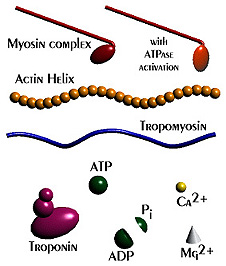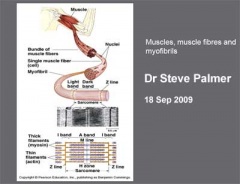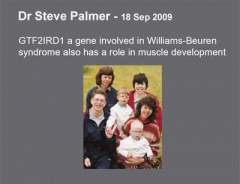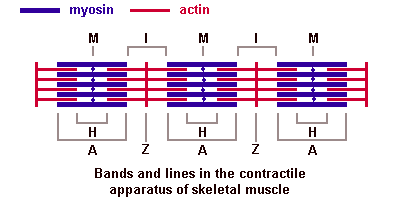2009 Lab 7
Muscle Development
Introduction
This laboratory will look at the musculoskeletal development. The laboratory will also allow time for work on the group online project.
Objectives
- Understand the origin, differentiation and development of skeletal muscle tissue.
- Know what is meant by patterning, conversion and adult plasticity of muscle fibre type.
- Develop an understanding of research methods for studying fibre type control.
Lab Tutorial
Today's laboratory will begin with a tutorial presentation on muscle development and research into muscle disorders. With any new concepts or terms, firstly use the terms list below or the glossary and feel free to ask questions about any concepts you may not still understand during or after the presentation.
Slides: Muscle Development - Part 1 | Muscle Development - Part 2
Presentation Slides 4 / page (printing version): Muscle Development - Part 1 | Muscle Development - Part 1
Lab Exercises
The following two exercises need to be completed in your group in today's lab and are not part of your assessment questions.
Exercise 1
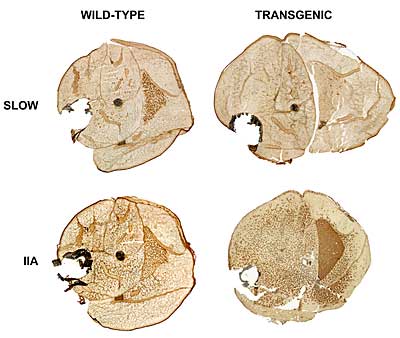
|
Questions
Click the image or Exercise 1 to open full size image. |
| Transverse sections through the lower hind-limb of adult GTF2IRD1-transgenic and wild type mice – stained for MyHC type I/slow and MyHC2A. |
Exercise 2
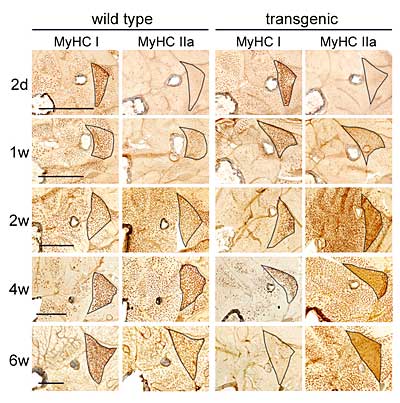
|
Questions
Click the image or Exercise 2 to open full size image. |
| Transverse sections through the lower hind limb of transgenic and wild type mice from 2 days after birth to 6 weeks. |
Lab 7 Assessment Questions
Answer the questions shown below on your own student page.
- Briefly; what is a myotube and how is it formed?
- What changes would I expect to see in the muscle fibre types in my legs if I:
- a) Suffered a spinal cord injury
- b) Took up marathon running
Questions are also shown listed on the Students Page Lab 7 Assessment
Terms
anterior tibialis - (tibialis anterior) skeletal muscle situated on the lateral side of the tibia and is a direct flexor of the foot at the ankle-joint.
cis-acting elements - DNA sequences that through transcription factors or other trans-acting elements or factors, regulate the expression of genes on the same chromosome.
enhancer - A cis-regulatory sequence that can regulate levels of transcription from an adjacent promoter. Many tissue-specific enhancers can determine spatial patterns of gene expression in higher eukaryotes. Enhancers can act on promoters over many tens of kilobases of DNA and can be 5' or 3' to the promoter they regulate.
extensor digitorum longus - (EDL) skeletal muscle situated at the lateral part of the front of the leg and extend the phalanges of the toes, and, continuing their action, flex the foot upon the leg.
Gtf2ird1 - General Transcription Factor 2 -I Repeat domain-containing protein 1. OMIM: Gtf2ird1
MusTRD1 - muscle TFII-I repeat domain-containing protein 1.
MyHC - acronym for myosin heavy chain.
myoblast - the undifferentiated mononucleated muscle cell progenitor, which in skeletal muscle fuses to form a myotube, that in turn expresses contractile proteins to form a muscle fibre.
myosin heavy chain - protein forming the thick filament of the sarcomere and the motor for actin-myosin contraction. There are 17 different myosin classes.
myotube - the initial multinucleated cell formed by fusion of myoblasts during skeletal muscle development.
promoter - A regulatory region a short distance upstream from the 5' end of a transcription start site that acts as the binding site for RNA polymerase II. A region of DNA to which RNA polymerase IIbinds in order to initiate transcription.
regulatory sequence - (regulatory region, regulatory area) is a segment of DNA where regulatory proteins such as transcription factors bind preferentially.
soleus - skeletal muscle situated immediately in front of the gastrocnemius and when standing taking its fixed point from below, steadies the leg upon the foot and prevents the body from falling forward.
Troponin - striated muscle contraction is regulated by the calcium-ion-sensitive, multiprotein complex troponin and the fibrous protein tropomyosin. Troponin has 3 subunits (TnC, TnI, TnT) and is located on the actin filament. OMIM: Troponin I slow
visuospatial deficiency - performing the Delis hierarchical processing task, subjects are asked to copy a large global figure made of smaller local forms. Both Down syndrome (DS) and William-Beuren syndrome (WBS) groups fail but in different ways. WBS individuals produce the local elements and DS individuals produce only the global forms. PMID: 12952863 Hum Mol Genet.
William-Beuren syndrome - (WBS) rare developmental disorder (1/20,000–1/50,000 live births). A contiguous gene deletion syndrome resulting from the hemizygous deletion of several genes on chromosome 7q11.23. The syndrome has associated craniofacial abnormalities, hypersociability and visuospatial defects. OMIM: William-Beuren syndrome
References - Dr Palmer
- Expression of Gtf2ird1, the Williams syndrome-associated gene, during mouse development. Palmer SJ, Tay ES, Santucci N, Cuc Bach TT, Hook J, Lemckert FA, Jamieson RV, Gunnning PW, Hardeman EC. Gene Expr Patterns. 2007 Feb;7(4):396-404. PMID: 17239664
- MusTRD can regulate postnatal fiber-specific expression. Issa LL, Palmer SJ, Guven KL, Santucci N, Hodgson VR, Popovic K, Joya JE, Hardeman EC. Dev Biol. 2006 May 1;293(1):104-15. PMID: 16494860
- hMusTRD1alpha1 represses MEF2 activation of the troponin I slow enhancer. Polly P, Haddadi LM, Issa LL, Subramaniam N, Palmer SJ, Tay ES, Hardeman EC. J Biol Chem. 2003 Sep 19;278(38):36603-10. PMID: 12857748
Search
- Bookshelf muscle development | muscle fiber type | troponin
- Pubmed muscle fiber type | troponin | Gtf2ird1 |
UNSW Embryology Links
- Musculoskeletal Development
- Muscle Development
- Development Timeline
- File:Muscle development 1-Talk1 muscle development.pdf
- File:Talk1 muscle development 4 per page.pdf
- File:Part 2 Muscle Development.pdf
- File:Part 2 Muscle Development 4 per page.pdf
Links
- Blue Histology Skeletal Muscle histology
- Primer Skeletal Muscle Fiber Type: Influence on Contractile and Metabolic Properties
- Gray's Anatomy of the Human Body - The Muscles and Fasciæ of the Leg | Cross-section through middle of leg
- Wiki Skeletal muscle | Troponin
- OMIM: Gtf2ird1
- OMIM: William-Beuren syndrome
Glossary Links
- Glossary: A | B | C | D | E | F | G | H | I | J | K | L | M | N | O | P | Q | R | S | T | U | V | W | X | Y | Z | Numbers | Symbols | Term Link
Course Content 2009
Embryology Introduction | Cell Division/Fertilization | Cell Division/Fertilization | Week 1&2 Development | Week 3 Development | Lab 2 | Mesoderm Development | Ectoderm, Early Neural, Neural Crest | Lab 3 | Early Vascular Development | Placenta | Lab 4 | Endoderm, Early Gastrointestinal | Respiratory Development | Lab 5 | Head Development | Neural Crest Development | Lab 6 | Musculoskeletal Development | Limb Development | Lab 7 | Kidney | Genital | Lab 8 | Sensory - Ear | Integumentary | Lab 9 | Sensory - Eye | Endocrine | Lab 10 | Late Vascular Development | Fetal | Lab 11 | Birth, Postnatal | Revision | Lab 12 | Lecture Audio | Course Timetable
Cite this page: Hill, M.A. (2024, April 27) Embryology 2009 Lab 7. Retrieved from https://embryology.med.unsw.edu.au/embryology/index.php/2009_Lab_7
- © Dr Mark Hill 2024, UNSW Embryology ISBN: 978 0 7334 2609 4 - UNSW CRICOS Provider Code No. 00098G

